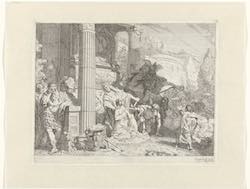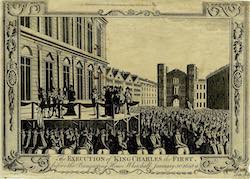Topic: 3. Sacrifice and politics (16th-18th Century)
During the transformative period of the 16th to 18th centuries, the notion of the State evolved into a nearly mystical entity, perceived as immortal and worthy of the ultimate sacrifice. This section delves into the complex interplay between sovereignty, resistance, and sacrifice, a theme explored by early proponents of political tolerance. It also examines revolutionary acts and regicide, viewed through the lens of sacrificial rites. This section includes early modern printed and iconographic sources, along with a comprehensive bibliography from the 19th to 21st centuries, providing a historical and modern perspective on this complex theme
King Jeroboam Making Sacrifice to the Golden Calf (17 - 18)
Staten Museum for Kunst, Copenhagen
State Sacrifices and Music in Ming ChinaOrthodoxy, Creativity, and Expressiveness
New York: State University of New York Press, 1998.
The Last Controversy over Ritual Murder? The Debate over the Paintings in Sandomierz Cathedral
in: Polin: Studies in Polish Jewry Volume 16: Focusing on Jewish Popular Culture and Its Afterlife, pp. 483-490
Liverpool: Liverpool University Press., 2003.
Histoire d'Angleterre, de Cosse, et d'Irlande; avec un abregé des évenements les plus remarquables arrivés dans les autres etats; par Monsieur De Larrey, conseiller de la cour et des ambassades du Roi de Prusse. Tome quatrieme, qui contient l'histoire depuis Charles I jusqu'a Guillame III inclusivement. Enrichi des portraits des rois, reines, et autres personnes illlustres
Rotterdam: Fritsch et Böhm, 1713.
The History Of The Troubles And Tryal Of The Most Reverend Father in God, and Blessed Martyr, William Laud, Lord Arch-Bishop of Canterbury. Wrote by himself, during his Imprisonment in the Tower. To which is prefixed the diary of his own life. Faithfully and Entirely Published from the Original Copy: and subjoined a Supplement to the Preciding History The Arch-Bishp's Last Will; His Large Answer to the Lord Say's Speech Concerning Liturgies; His Annual Accounts of his Province Delivered to the King; and some other Things related to the History.
London: Chiswell, 1695.
Holy Scripture, Theology and Violence. Terror and Samson in Early Modern Era
in: Christianity and Violence in the Middle Ages and Early Modern Period. Perspectives from Europe and Japan, pp. 35-53
Berlin - Boston: De Gruyer, 2021.
Ways of Self-Transcendence: On Sacrifice for Nothing and Hyperbolic Ontology
in: Interdisciplinary Journal for Religion and Transformation in Contemporary Society, v. 8 (2022), issue : pp.305-320.
Regulus Returning to Carthage (1791)
The State museum Hermitage, Saint Petersburg
Autorità, dovere, sacrificio. Il discorso di guerra di mons. Angelo Bartolomasi (1915-1918)
in: Rivista di storia del cristianesimo (special issue: Sacrificarsi per la patria. L'integrazione dei cattolici italiani nello Stato nazionale), v. 8 (2011), issue 1: pp., v. 8 (2011), issue 1: pp.45-61.
Sanctuary, Sovereignty, SacrificeCanadian Sanctuary Incidents, Power, and Law
Vancouver: UBC Press, 2011.
The Blood Sacrifice Complex
Menasha, WI: American Anthropological Association, 1924.
Dr. Walker's True, Modest, and Faithful Account of the Author of Eikōn basilikē, Strictly Examined, and Demonstrated to Be False, Impudent, and Deceitful. In Two Parts, the First Disproving It to Be Dr. Gauden's. The Second Proving it to Be King Charles the First's
London: R. Talor, 1693.
‘Dead Women Tell No Tales:’ Issues of Female Subjectivity, Subaltern Agency and Tradition in Colonial and Post-colonial Writings on Widow Immolation in India
in: History Workshop Journal, v. (1993), issue : pp.208-227.
Philosophia antigua poetica del doctor Alonso Lopez Pinciano, medico cesareo. Dirigida al Conde Iohanes Keuehilerde Aichelberg, Conde de Frankemburg, Baron absoluto de Landtscron y de Wernsperg, Señor de Osteruiz y Carlsperg, Cavallerizo Mayor perpetuo y hereditario del Archiducado de Carinthia, Cavallero de la orden del Tuson del Rey nuestro señor, y del Consejo y de la Camara del Emperador, y su Embaxador en las Españas
Madrid: Thomas Iunti, 1596.




